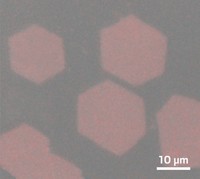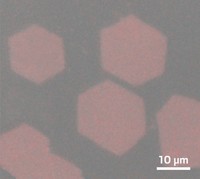Advertisement
Grab your lab coat. Let's get started
Welcome!
Welcome!
Create an account below to get 6 C&EN articles per month, receive newsletters and more - all free.
It seems this is your first time logging in online. Please enter the following information to continue.
As an ACS member you automatically get access to this site. All we need is few more details to create your reading experience.
Not you? Sign in with a different account.
Not you? Sign in with a different account.
ERROR 1
ERROR 1
ERROR 2
ERROR 2
ERROR 2
ERROR 2
ERROR 2
Password and Confirm password must match.
If you have an ACS member number, please enter it here so we can link this account to your membership. (optional)
ERROR 2
ACS values your privacy. By submitting your information, you are gaining access to C&EN and subscribing to our weekly newsletter. We use the information you provide to make your reading experience better, and we will never sell your data to third party members.
2-D Materials
Hydrogen ions smooth out wrinkles in graphene films
Technique yields large, ultra-flat graphene films necessary for high-quality electronics
by Prachi Patel, special to C&EN
January 13, 2020

When researchers grow graphene films, wrinkles often form in the 2-D material, impairing its electrical properties. Now researchers have found a way to make large graphene films free of even the tiniest wrinkles (Nature 2020, DOI: 10.1038/s41586-019-1870-3). The ultra-smooth films could enable large-scale production of electronic devices that harness the unique physical and chemical properties of graphene and other 2-D materials.
Chemical vapor deposition (CVD) is the best-known method for making high-quality graphene sheets. It typically involves growing graphene by pumping methane gas onto copper substrates heated to temperatures around 1,000 °C, and then transferring the graphene to another surface such as silicon. But some of the graphene sticks to the copper surface, and as the graphene and copper expand and contract at different rates, wrinkles form in the graphene sheets.
These wrinkles present hurdles for charge carriers and lower the film’s conductivity. Other researchers have tried to reduce wrinkles using low growth temperatures or special copper substrates, but the wrinkles have proven difficult to eliminate entirely, says Libo Gao, a physicist at Nanjing University.
Gao and his colleagues found that carefully harnessing protons during CVD can fully flatten the wrinkles. They used a method called plasma-enhanced CVD, in which reactive plasma is introduced into the growth chamber, allowing graphene growth at a lower temperature of 650 °C, an important step toward growing graphene directly on other substrates without having to transfer it.
The team used a plasma of hydrogen gas, which contains a mix of hydrogen atoms, electrons, and protons. Only the electrons and protons permeate the graphene films, recombining underneath to form hydrogen gas between the graphene and copper substrate. These gas pockets keep graphene from sticking to the copper, giving wrinkle-free graphene films.
It takes a few minutes to grow ultra-flat graphene sheets on a roughly 10-cm copper substrate, and the method could easily be used on larger substrates, Gao says. The proton-assisted method could also be used to grow other wrinkle-free 2-D materials. What’s more, Gao says, the method could lead to a new hydrogen storage system in which the gas is stored between layers of 2-D materials. His team is now exploring this idea.
One limitation of the process, says Zhongfan Liu, a physical chemist at Peking University, is that the decoupling of graphene from the substrate results in graphene growing in different directions, yielding a multicrystalline film instead of a single-crystal film. Single-crystal films produce higher-quality devices. Nonetheless, he adds “this advance is critical for the killer applications of graphene in high-performance electronics and optoelectronics because of its good compatibility with wafer process and the improved properties on a large scale.”





Join the conversation
Contact the reporter
Submit a Letter to the Editor for publication
Engage with us on Twitter